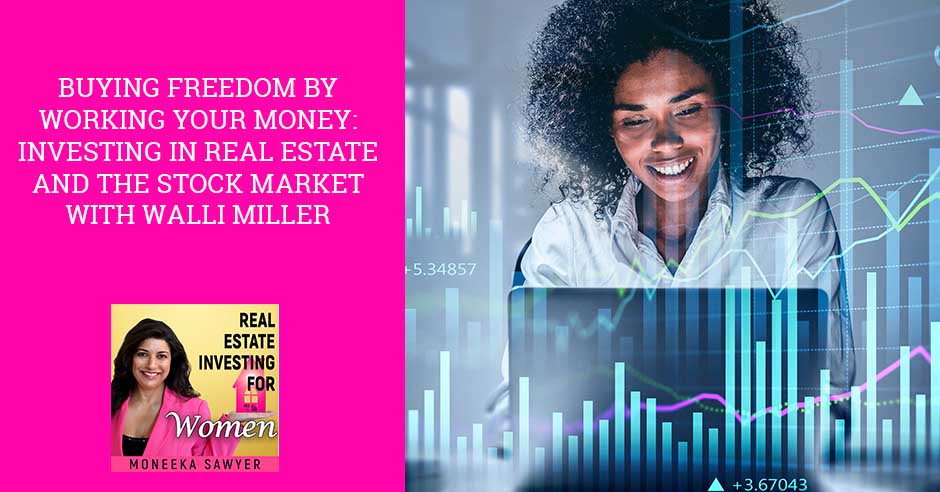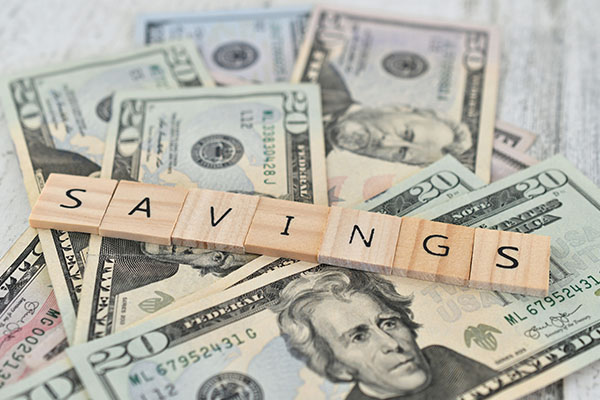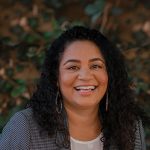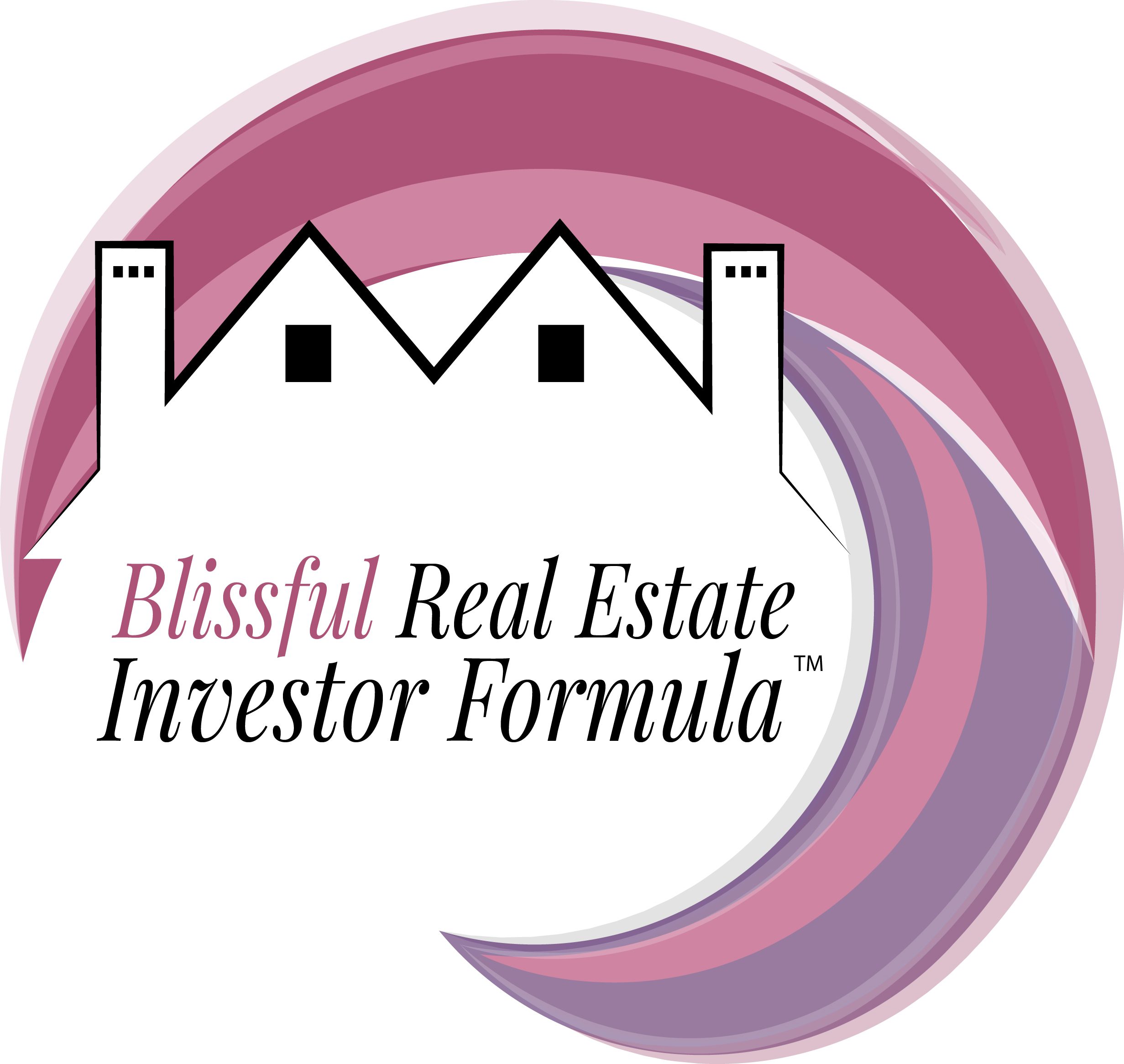Buying Freedom By Working Your Money: Investing In Real Estate And The Stock Market With Walli Miller

The best way to make your money work for you is to start investing. Stop spending aimlessly and start cutting the fat. Do you really need that brand new pair of shoes? Instead, you can invest that money so that you can build towards your goal and your future. You are buying your freedom so that one day you don’t have to work anymore. Join Moneeka Sawyer as she talks to money nerd and money coach, Walli Miller about proper investing. She helps young professionals take control of their finances without sacrificing luxury. Learn how to become work-optional so that you can have that freedom you always wanted. Find out the importance of having a diversified portfolio, why you should invest in the stock market, and why you should have multiple savings accounts.
—
Watch the episode here
Listen to the podcast here
Buying Freedom By Working Your Money: Investing In Real Estate And The Stock Market With Walli Miller
I am so excited to welcome to the show Walli Miller. She is a financial coach and a self-proclaimed money nerd. She loves spreadsheets and has been known to watch PBS Specials about retirement for fun. It’s exactly this passion for all things money, including spending it, that put her on the path to her true calling, helping high achieving young professionals become work optional by taking control of their finances without sacrificing their lattes and brunches.
While she didn’t start as an expert, she is a first-generation college graduate and daughter of immigrants. She didn’t always understand money or building wealth. She didn’t grow up looking at stock charts with her dad or balancing the checkbook with her mom. They didn’t talk about money much in her family. It took a Forbes article to make her reevaluate what she was spending money on and the true cost of her purchases.
After that, Walli began listening to podcasts, reading personal finance books and ingesting every bit of financial information she could find. She will be working optional and is committed to putting as many people as possible on that path to financial freedom through balance spending, saving and wealth-building without deprivation. Walli, that is quite a bio. Welcome to the show.
Thank you so much for having me, Moneeka. I’m excited about talking about all things money.
I love that this conversation is going to be a little bit different. Ladies, Walli came to me from somebody who books many of my guests on my show. She was also referred to me by two other people. I don’t know if you know this, Walli. She’s part of the FIRE movement, Financially Independence, Retire Early. Her idea about retirement is very similar to mine, which is not retiring on the beach with a drink and an umbrella in it. It’s more about being work optional. What are you going to do with all that time when you’re fully retired?
I’m sure many of us could find the things to do but it’s nice to be able to have the option. Either you work or you don’t work, you’re on vacation or aren’t on vacation. We were talking about Africa and she was like, “I’d like to go hang out there for three months.” It’s being able to make those choices. There’s all of that with Walli and that’s why she was referred to me by so many people. What’s also interesting is although Walli is a real estate investor, she does not consider that her primary wealth-building tool. She tends to invest more in the stock market. What I love about that is, first of all, that it’s very aligned with my strategy. I manage real estate. My husband manages the stock market.
We discuss both. Both of us are fully aware of what’s happening. We help each other with decisions but each of us is responsible. There’s a division of labor as far as who’s watching what. It’s very important the diversification of investments so that you have different levels of liquidity, appreciation and cashflow. Different asset types give you different kinds of benefits. Walli is going to tell us a little bit about her real estate story. What I want you to talk about is how did you reach financial freedom? How to do that with the stock market?
Diversifying is really important in real estate. Counting on one tenant only can be a really scary thing. Share on XLadies, that will give you a little bit better idea of how you might add that if you want to into your portfolio. If you have very little money and you’re just getting started, you need to pick one strategy. I want to be clear about that. You grow that and diversify. It’s good to have the knowledge base to know, “This is something that I aspire to.” If you’ve already got enough of a portfolio that you can diversify, this might be the way to do it. We’ve had a few other people on the show talk about stock. You already knew this but it’s been a little while. I thought it was appropriate to bring Walli on.
There’s one of the key things that you said there. Diversifying is important. When we’re thinking even about real estate, having 1 property and counting on 1 tenant only can be scary. We know that the markets fluctuate. Sometimes it’s a hot stock market and a bullish market. Sometimes real estate is doing much better. Having a diversified portfolio is important for your financial independence and the success of your nest egg.
You get a lot more volatility with the stock market, which you can benefit from. The real estate market is much more stable. It’s a hard asset. Even when it goes down, you can hold onto it and eventually, it will usually recover, not 100% all the time. They’re different kinds of assets that can give you a different level of safety and stability but also different levels of growth and losses.
I am a buy-and-hold real estate investor and a buy-and-hold stock market investor. If you’re thinking about turning $1,000 now into $1 million tomorrow, that is not the strategy that I use. I don’t know how many people can do that but with that, the volatility evens out. The risk of losing as much money is lessened. For example, if you’re going to do a flip, you need to make sure that you flip that house right away. You have holding costs that you might need to take into consideration, whether or not you’re going to have a buyer. There are all these different ways of investing both in the stock market and real estate.
The reason why I like the stock market is not necessarily because the growth is so much better or worse. It’s because it’s the lazy way. It is one of the easiest and simplest ways for me that I have found, even as a real estate investor. My husband and I have tried to add properties, being under contract and looking at all these things. There are some ways to mitigate that if you have a great team but when you’re starting, I’ve found that I can set it and forget it when it comes to stock market investing. That’s why I prefer it a little bit better.
It’s so interesting that you say that because my real estate business is a set it and forget it. There is a lot of front-end research and stuff like that that has to happen when I’m buying a new property. I find that the same with my husband with the stock market. He’s reading newsletters and doing research. He does a ton of research on every stock that he buys because we hold them long-term. There is also a lot of front-end research that happens. He does a set-and-forget type of thing too.
You can do that on both sides. Although I will say on both sides, there are opportunities to work a lot harder depending on what you’re doing, how quickly you want to make your money and how much risk you’re willing to take all of those things. There are a lot of different ways to make money on both sides, whether it’s stock, real estate or any investing.

Investing Money: The reason why it’s better to invest in the stock market is not necessarily because the growth is so much better or worse. It’s because it’s the lazy way compared to real estate.
One of the reasons why I like real estate is because of the cashflow, which is very different than investing in the stock market. It’s understanding first what type of investor you want to be. Do you want to have a more active role or a more passive role? My real estate is pretty passive. I have a property manager. I get about two phone calls a year and that’s about it.
It’s not as passive as I could make it for me but so is my stock market investing. There’s an active investor and a passive investor. It’s one of the ways to be a more passive investor in the stock market, instead of thinking about all of the research in separate companies or individual companies. I don’t have the time for that.
I don’t want to look at sixteen different screens, read financial reports and look at all of the different analysts and out in the list reports. I want to do all analyzing. I prefer the index market and investing in index funds. It’s a little bit of investing in the stock market. What is an index fund? When most people come to me, they’re like, “I want to start investing. What should I buy?”
I’m like,” I wish I could tell you these 2, 5 or 10 companies are going to be the next best thing and are going to give you the most bang for your buck.” We don’t know. When we think about Kodak, for example, back in the day, Kodak was the monster. They were the beast in their fields. Now, you ask the Gen-Z and they’re like, “What’s a Kodak?”
Don’t try to think about what are the companies that are going to be the next best thing. It has this risk because we don’t know. Past indicators are no indication of what’s going to happen in the future. Rather than trying to find individual companies, I like to invest in an index. For example, the S&P 500 index. What is S&P 500? We probably heard, “The NASDAQ is up. The Dow Jones is down.” The S&P 500 is simply the top 500 companies in the United States. I don’t have to think about what company should I invest in?
I purchased an index fund and got the best top 500 companies out there. I get a lot of diversifications that way. Maybe my investing style might be even more passive. That’s why I say it’s the lazy way. I don’t need to look at research, reports and things like that. It’s a self-cleansing index. If the companies start doing poorly, they get taken out and the next best companies put in without me having to do anything. That is one of the ways that I invest and why I consider myself a lazy investor.
How did you start and build your portfolio so that you can become job optional or work optional?
If you don't have a clear goal about what you're saving for and why that's important, you won't be motivated to save money. Share on XI made some bad mistakes when I was in my twenties. I got a good-paying job. I was able to stay out of credit card debt. I was paying off my student loans but I didn’t know what to do with the leftover money. I did put some money into savings but how much are you supposed to save? This is one of the biggest hurdles that people have to get motivated to save.
If you do not have a clear goal, purpose and passionate why about what you’re saving for and why that’s important to you, it’s not motivating to save money. I didn’t have a clear passion for what I was saving for. I wasn’t even thinking about retirement. I was in my twenties and retirement seemed so far away. I didn’t even know how to do that properly.
What did I do with the leftover money? I spent it. I enjoyed life, went to restaurants, traveled and bought a lot of shoes and clothes. It wasn’t until I realized I had received a Social Security earnings statement. You get it, maybe after a decade of work. You can go to the Social Security Administration website and it gives you a listing of your whole lifetime earnings.
When I looked at that and added up every dollar that I had ever made from my first job when I was fourteen years old to the present day, I couldn’t believe the amount of money that I had made. I had nothing to show for it. I didn’t have my savings account. My bank account balance did not reflect that and that was when I realized that I had to do something different.
The second thing that happened was that I was in a 9:00 to 5:00 career corporate job. I liked my job until things changed. We had a shift in management. There was a lot of bureaucracy. My ideal workplace became very toxic. It was at that moment that I realized, “I am going to have to be here for the next 20 or 30 years.” It seems so devastating to me because even if I had switched employers, I knew that something like this could happen. That was when I realized, “I need to do something. I am missing the mark here. What is it that I can do?”
I went to the land of Google to figure out how I could retire early? What am I missing? What is this wealth-building journey? It was at that point that I discovered that the component that I was missing was wealth building. I didn’t even connect with that word. To me, when I thought about wealth, I thought of it as an older man in a velvet robe, smoking a cigar. I didn’t even know what wealth-building meant to me. What does wealth mean? I wasn’t an actor, a singer or an athlete.
I was like, “How am I going to build wealth?” I had to redefine what wealth meant to me and what I wanted was freedom over my time. I wanted to spend with loved ones and travel. I couldn’t do that in a 9:00 to 5:00 job, even with paid vacation. There are some limitations there. That was when I turned to that component that I was missing, which was wealth building.

Investing Money: Before you start investing, understand first what type of investor you want to be. Do you want to have a more active role or a more passive role?
How did you start that journey? What were the steps that you took?
One of the first things I said was, “I don’t have money to invest.” I understand that compounding growth is the key but I don’t have any money to invest but that wasn’t true. I had to get intentional and real about what I was doing with my money. I looked at what my take-home pay was and my most essential expense. Keeping the lights on, a roof over my head and food on the table was essential expenses. When I looked at the difference between what my take-home pay was and what my expenses were, I said, “I don’t have this leftover money every month. What is going on?”
I had a shopping problem. I was a pretty impulsive shopper. I began to reel that in. What I began to think when I went to make purchases was, “Is this shirt or pair of pants worth it?” I could buy this pair of shoes, shirt, pants, whatever it was or I could use this to build wealth. What I was saying was I could use this to buy my freedom. I began to be more intentional. I went from impulsive shopping and being a mindless vendor to being a more intentional spender.
It was at that point that I widened the gap between what I needed every month and what I was spending every month and with that leftover, I began to invest. This is not about deprivation. It wasn’t that I wanted to cut out all the things that I loved but when we think about expenses, we need to think about this acronym, cutting the FATT, Food, Accommodation, Transportation and Taxes, those four things.
As a higher-income earner, I realized a lot of my paycheck was going to taxes. I realized that the IRS rewards those who save for their future. I began to use those types of accounts like a 401(k), 403(b) or an IRA. If you’re self-employed, you have even more tax benefits. I began to learn a little bit more about that. I took the passive way, the easiest and the simplest road to start investing, which was that I realized that I didn’t have to do all of the analysis on all of the companies.
I didn’t have to sit down and do all of the research. I could buy something like the S&P 500 index, which would give me that diversification and growth that I needed. When we think about 2020 in the middle of the pandemic, the S&P 500, the average growth of the top 500 companies was 20%. In 2021, it was 27%. That’s not going to happen every year but think about savings accounts, which I don’t know about you, Moneeka but my savings account earns me less than 1%. Saving money isn’t going to be enough. Finding ways to find a better growth and rate of return is what made the difference.
Did you have a strategy each month? Here are a couple of different things that my husband and I did to get the money flowing into our other investment accounts. We had an automatic withdrawal. Every single month, he would get paid on the 1st and the 15th or I would get paid on the 1st and the 15th. Every single paycheck that went in, 10% came out and immediately went to our brokerage account.
When you think about expenses, cut the FATT. Cut your food, accommodations, transportation, and taxes. Share on XIt was a literal automatic transfer and $500 goes every month to this. It was a budget item. I don’t budget now because I didn’t have to but back then, I certainly did. It was a budget item. That was not something we cut. We would cut going out to dinner or vacation but we wouldn’t cut that. Did you have some strategies on how to grow the funds that went into your investing?
I had to get clear about where my money was going. I realized that I had something called budget leaks or wallet leaks. I would go to Target to buy toilet paper and laundry detergents. The next thing you know, I spent $100 on home decor. I was becoming more aware of my spending habits and spending patterns. I realized, “If I can become a more intentional spender and mindful about where my money is going and what I’m spending my money on, I can increase and widen that gap between the amount of money that I spend every month and what’s leftover.”
What was leftover? I did a couple of things. The first thing was that I believe and I know you’ve talked about this too, your cash, emergency fund and rainy day fund need to be there. That is not investing money and it is not meant to grow. That money is there to provide that safety net or cash cushion. That was the first thing that I did. I focused on making sure that I had cash reserves available to me for when the tire was going to blow out in the car, I needed to replace something in the house or whatever that case might be. If I had a loss of income from my job, I was able to cover my most essential expenses. Once I had enough money in cash reserves, I went into investing and I believe in automation.
With the cash reserves, where did you put that? Was that a savings account or a money market account?
The cash reserves were in a money market account and savings account. I have a little bit of a different strategy because we’re in a unique situation. Back in the day, CDs or Certificate of Deposits could help you grow a little bit. You would get a little bit higher interest on that money. I remember when CDs were 5% and 6%. Long gone are those days. My husband and I have about a year’s worth of cash. A lot of people are going to cringe because they’re like, “Inflation is eating that away.” My husband would go with much less but I need to sleep at night and I like to have a bigger cash cushion. What we decided to do was that we had about three months available in cash sitting in a savings account.
We have the remaining money in something called an I Bond. That can be a little bit technical. If you have not read up on I Bonds, it’s something to consider if you are someone who likes to have a lot of cash on hand and sitting in a savings account earning 1% or less may not be there for you. I like to consider I Bonds not as an investment but more as a CD because your money does need to be locked away for about twelve months. I Bonds are returning 7% and are going to be returning 9%. It’s not going to be forever but at least for the next several months, a little bit of money that I have put in there can grow that 7% and 9%.
You built your cushion and then after that, you started to create an investing account and invest. Talk to me about that. How did that go?

Investing Money: Ask yourself, is this shirt or pair of pants worth it? You could either buy those pants or you can use this to build your wealth. In other words, you could use it to buy your freedom.
The first thing that I did was focus on how high my taxes were. I began to use my workplace retirement accounts to reduce my taxable income. Let’s say, for example, you bring home $70,000 a year in a 401(k), 403(b) or a thrift savings plan, depending on what type of retirement plan you have. In the year 2022, you can contribute up to $20,500. That doesn’t mean you have to do the total amount but that’s the amount that the IRS allows for you. If you are making $70,000 and you contribute $20,000 into a 401(k), you have instantly reduced your taxable income.
Your taxable income which is in that $70,000 salary, is down to $50,000. This is where we have those debates. “How come I make a lot less and pay more taxes than you?” This is one of the ways. This is not a tax loophole. This is a tax rule and tax benefit. That was one of the first places that I started focusing on. I wanted to increase slowly.
It took me about two years because I couldn’t do it all in one shot. Going from being an over-spender, I needed to reel in that spending. As I did that slowly, every month, I increased the contributions to my workplace retirement account until I was able to give the maximum contribution. Back then, it wasn’t $20,000. It was about $16,000.
For people who say, “I already contributed the maximum amount to my retirement account. Is there something else?” Here’s another retirement type of account that has awesome benefits. It’s a Roth IRA or a traditional IRA. I prefer the Roth IRA but not everybody can qualify for that because there are some income limitations. If you don’t qualify for a Roth IRA or you are able to put money into a Roth IRA and you put money into that Roth IRA as well, what do you do?
Open a taxable brokerage account. This is where you can have an account at Vanguard, Fidelity or Charles Schwab, some of the dinosaurs in the world. They’re reputable. Find low-cost funds. One of the mistakes that people will do is that they will say, “I invested $1,000 but there were these fees, management fees and expenses.”
Be aware of what type of investments you’re purchasing so that you’re not paying those transaction fees. You can keep them to a minimum. That was what I did. I first worked on my workplace retirement account, worked on my Roth IRA and the money that I had leftover was when I started investing into a taxable brokerage account but my philosophy stayed the same. I didn’t go into more speculative bets and risky investments. I either invested in a total stock market or the S&P 500 index.
Since 2015, my husband and I have been able to build a seven-figure portfolio. A lot of people do not like the idea of retirement accounts because it’s not very sexy. They’re like, “I want to do the game stop or the AMC.” It is getting rich slowly. If you think from 2015 to 2021, which was when we hit our seven figures for the first time, it can happen. You have to be consistent. I love what you mentioned about keeping it automated. Do these automated returns, set it and forget it. The only time you should think about it again is when you get your next raise. “I got a 3% raise. Can I raise my investment?”
Be aware of what type of investments you're purchasing so that you're not paying extra transaction fees. Share on XWith your 401(k), IRAs or Roths, all of those things you do, you can also invest. Usually, they’ll say it’s self-directed IRA, which on this show, it means a different thing. What they’re talking about if it’s a brokerage account is it means that you can pick your investments. With those custodians, you can then pick whatever fund, stock or index you want to be in. Any of those things can be picked. Her strategy is consistent throughout the entire thing, from the very beginning down to where she’s got a lot more freedom with what she’s investing in and she’s still picking the same types of investments.
I love your example. From 2015 to 2021, if you think about this, let’s say, for instance, you’re going for the next game stop, AMC, Bitcoin or whatever it is that you’re going for, you make a huge return, lose, make a huge return and lose again. You’re going to be wrong some of the time too. Doing that, you’re much less likely to reach 7 figures in 6 years than if you were to grow slowly consistently. This is something people need to hear in real estate too. Sometimes we’re chasing so hard that we forget that if we stopped chasing and allowed that, it would grow.
Many people that have a huge nest egg are like, “I want to grow it fast.” They lose the whole nest egg. If you allow it to grow slowly, 6 years is not slow but you can cause a lot of damage in 6 years if you’re chasing the high return, high-risk type of investments. We all have different levels of risk aversion. I have my play accounts that are very high risk.
We have our safe accounts. We do our ESPP. I don’t know if you did this too. This was also forced investment. If you work at a company, they’ll often have an Employee Stock Purchase Plan. What’s cool about these is most of the time, you can take a look at it in your company but you get the stock at 15% of its value. On the very first day that you buy it, you can sell it with a 15% profit. That’s 15% in 2 days.
You can take that money either sell it or not because you have to pay taxes on it, short-term gains and it’s your income tax rate. We tend to hold it for a year because it becomes capital gains, which is only 20%, which is low for us. When you look at the ESPP, a lot of people are like, “I don’t want to do the ESPP. It doesn’t make sense. We can’t afford it.” You’re making 15% in 1 day. Even if you pay income tax rates, so let’s say you’re at a 25% income tax rate, you’re still only paying 25%.
It’s 25% of 15%. You’re still way over 11% that you made in that 1 day on that ESPP. That was a lot of numbers. They’re probably not correct but it gives you an idea of when you’re looking at where to put your money, there’s only a certain percentage of your money that can go into the ESPP. It’s the same as with a 401(k). David and I max out everything. Why? It’s forced savings. This is all automation. We don’t think about this.
When he switched jobs, he said, “Here are all the things and our benefits. What do you want?” We consistently pick the same things. We’re going to do the 401(k) and max out our ESPP and charitable contribution matching that they do. In our 401(k), they do matching. We are consistent about putting in the accounts that will match because some investments and our contributions won’t match.

Investing Money: Focus on making sure that you have cash reserves available at all times. Build that safety net. Once you have enough money in cash reserves, then you can start investing.
We look at these different things and say, “These are the things.” We don’t think about it. It doesn’t matter. I know what my paycheck is. When it comes in twice a month, I know what my budget is. I’m not debating every single month, should we be saving this or that? We’ve got our liquid assets, which go into another account that comes out automatically. I’ve got my real estate money. We’ve got it distributed in a way that we don’t ever think about the money except what to do with it because that’s fun. We’re not thinking about what’s going where?
David and I have been together for many years. This is a plan that has been worked on by us for many years. It didn’t happen at all in the very beginning. In the very beginning, we were dead broke when we first got together. It was a recession. Things were a nightmare. We were both right out of college. I couldn’t find a job. It was hard. We house hacked our first house. We could only put 5% down. It took time for us to get here but it’s a thoughtless process and automated.
I love what you’re talking about, Walli. There has to be some intention. I love that you set the plan. We need to have a buffer in our life to save us every single time something goes wrong. We had a little puppy that I loved to pieces. I loved Humphrey. He was in the hospital at least once a month. That little guy, probably in 1 year, cost me $20,000. He was so sick. I didn’t want to have to think about, “Should I pay for this and that for Humphrey?” We just did it because it was there. That doesn’t have to be important to everybody but that was important to us.
When you have a buffer, it saves you if you lose your job. David and I got laid off once. Suddenly, we had no job. I got no package. He got a package. Things happen in life. You have it in your life, in your business and real estate business. We have real estate money in case we’re losing rent. We have vacancies and a mold problem, which I had twice in 2022. We need new garages, water heaters or whatever it is. We’ve got our buffer there. I never stress about those things that are built into the business since I’ve got this buffer account. That was a lot of talking but I love how you’re talking about how you start. I remember so many years ago when I started that same way.
It’s important too to have the different buckets. One of the mistakes that I make and I see a lot of my coaching clients do is that they say, “I have a savings account.” All of the money for their savings is in one bucket. I’m like, “How much of that is for a pet emergency fund? How much of that is for a replacement car or a car maintenance fund? If you were to lose your job, how much of that could be dedicated to paying the mortgage?”
A lot of bank accounts will allow you to do that. You can have multiple savings accounts and label them in that way. I have a family emergency fund dedicated simply for when family emergencies happen. If I get a phone call that someone might need some money, I have money set aside. I have a travel fund. I’m not going into that travel fund to buy a new pair of boots. I have a real estate fund as well that is specifically for any issues that come up. I had to pay for a brand new HVAC system but I didn’t bat an eye because I knew that I had been putting money aside specifically for those things.
Everything hits the fan fund. Label every single account for those things rather than having all of the money in one pot. For some people, maybe it’s easy to have all that money in one pot but you need to have it written down somewhere or on an Excel spreadsheet, whatever the case might be, so that you know how much money is that pot dedicated to the different categories. That is something that I recommend to people because if you mix it all in, it can give us a distorted view of what our safety net is.
Keep your investments automated. Do these automated returns. Set it and forget it. Share on XThank you for that. I do a similar thing but not quite as distributed that way with our brokerage accounts that are allocated for different needs. Here’s another thing. I don’t know if you ever did this but this was helpful for me in the initial budgeting and trying to figure out what I could cut out. We went from cash purchases and checked purchases to everything on our credit cards. Not because we wanted to carry credit cards but because we never pay interest on credit cards. I have not done it since I was 25 years old. With the credit card, it’s a great budgeting tool because they will give you at the end of the month, “This is how much of your pie you spent on this.”
They tell you on your credit card how much of your monthly pie that went in was spent on what category like food, restaurants, entertainment, travel or whatever infinity utility services but also you can go through and look at it. I went to Target to spend $5 and spent $100. You see where it got spent. There was no question about where that money got spent. David and I would go through at the end of the month like, “These are the things that I can take out. We want to go on a trip. Maybe we stop eating at restaurants. We cook in for one month.” One month made enough of a difference.
We were able to use it as a budgeting tool. For whatever reason, I had to write five checks but I knew so we would go through our credit card bill where all the expenses were. I had 5 checks and we’d each pull $200 to put in our wallets if we needed it and we had spent it the last month. We could follow every single thing. It’s not like you have to write it down and think about it. It was all right there in black and white at the end of the month every single month. Do you do that or something like that?
I do but I do not think that credit cards are for everyone. If you have not been able to be responsible in the past, this may not be a strategy for you but I rarely ever carry cash, use my debit card or write checks. I put almost anything that I could do on a credit card. I don’t pay any interest. I pay off my credit card every two weeks. When I get paid, I’m going to log into my credit card, check out the transactions and make sure what I had allocated in certain categories like groceries, eating out or whatever the case might be, so it gets taken out. That is one strategy that I do.
The other reason why I like credit cards is I like to collect reward points and airline miles. My husband and I paid for our honeymoon to the Maldives using credit card points and airline miles. Given the pandemic, my husband and I take yearly international vacations and rack up those points. We’re rewarded. Credit cards hate us because we take advantage of every single point and we’re not paying interest. You can be strategic in using credit cards and it can be helpful.
I divide my credit card usage. I have one credit card that goes specifically for all my automated bills like my cell phones, utilities and things like that. I don’t use any discretionary spending on that card. The other one goes for all the discretionary spending. It’s things that I have in my budget. For example, haircuts, dining out, convenience dining, date nights or whatever those things might be. That goes on a separate credit card, so that makes sure that I have control of my essential expenses and I also know exactly what’s going on with that discretionary.
I do that same thing too. What I love about the credit card for all your automatic payments is I put that on my desk. If the other one gets stolen or hacked, I don’t have to change all those automatic payments again to the next credit card. It’s one that all my payments go into, like PG&E, T-Mobile and whatever I’m using. That monthly stuff all goes on this one credit card that nobody ever sees, not even me because I don’t want it to get lost, stolen and change all those accounts. I love that tip. I started that very early also.

Investing Money: It’s important to have multiple savings accounts. One of the mistakes that people do is that they have only one bucket for all their things. Have multiple buckets and label them accordingly.
I hadn’t even thought about that but I never had a card stolen or lost and had to change all of that. I love that idea.
That’s one of my big strategies.
Moneeka, I know you don’t consider yourself a money nerd. You’re a real estate maven but you are a hidden money nerd.
I am a money nerd but I don’t admit it often. In EXTRA, we’re going to be talking about you needing to decide what life you want and say no to everything else. Before we go there, let’s quickly talk about how people can get in touch with you.
Thank you so much for having me. It’s been a great conversation. I am most active on Instagram but you can visit me on my website, FinanciallyThriving.com and find all my social media handles there.
I’m not going to ask the three rapid-fire questions, ladies. Please forgive me because I do want to get to EXTRA. If you are subscribed to EXTRA, go there because we’re going to be talking about deciding what life you want, what we are shooting for this optional work lifestyle and how to say no to everything else. If you’re not subscribed, go to RealEstateInvestingForWomenEXTRA.com. For those of you that are leaving, Walli and I thank you so much for joining us for this portion of the show. I look forward to seeing you next time. Until then, remember, goals without action are just dreams. Get out there, take action and create the life your heart deeply desires. Talk to you later.
Important Links
- Walli Miller
- Social Security Administration
- Instagram – Walli Miller
- RealEstateInvestingForWomenEXTRA.com
About Walli Miller
 I’m a financial coach and money mentor who went from overspending and compulsive shopper to being debt-free and building multiple six-figure investment portfolio.
I’m a financial coach and money mentor who went from overspending and compulsive shopper to being debt-free and building multiple six-figure investment portfolio.
After spending my 20s spending every dollar I earned and saving very little I knew I had to start doing something different. The thought of working for the next 30 to 40 years just to survive wasn’t the life I wanted.
After gaining control of my finances and creating a plan, I’m on my way to being work-optional before the age of 40!
I’m a first generation college graduate, Latina, and daughter of an immigrant. Born and raised in the Bronx, I’m the first millionaire in my family.
To listen to the EXTRA portion of this show go to RealEstateInvestingForWomenExtra.com
——————————————————
Learn how to create a consistent income stream by only working 5 hours a month the Blissful Investor Way.
Grab my FREE guide at http://www.BlissfulInvestor.com
Moneeka Sawyer is often described as one of the most blissful people you will ever meet. She has been investing in Real Estate for over 20 years, so has been through all the different cycles of the market. Still, she has turned $10,000 into over $5,000,000, working only 5-10 hours per MONTH with very little stress.
While building her multi-million dollar business, she has traveled to over 55 countries, dances every single day, supports causes that are important to her, and spends lots of time with her husband of over 20 years.
She is the international best-selling author of the multiple award-winning books “Choose Bliss: The Power and Practice of Joy and Contentment” and “Real Estate Investing for Women: Expert Conversations to Increase Wealth and Happiness the Blissful Way.”
Moneeka has been featured on stages including Carnegie Hall and Nasdaq, radio, podcasts such as Achieve Your Goals with Hal Elrod, and TV stations including ABC, CBS, FOX, and the CW, impacting over 150 million people.
